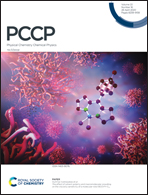First-principles study of χ3-borophene for charge-modulated switchable CO2 capture
Abstract
A first-principles calculation was performed to investigate the switchable CO2 capture on χ3-borophene by injecting/removing the extra electrons. The results show that the CO2 adsorption energy on the neutral χ3-borophene is 0.150 eV. After extra 2.5 e are injected, the adsorption energy is raised up to 0.802 eV, showing a significant enhancement with the change from the physical adsorption to chemical adsorption. Furthermore, both the CO2 capture and release processes are exothermic reactions involving injecting/removing extra electrons. χ3-borophene possesses a metallic electronic structure, which is conducive to the injection of extra electrons. The minimum charge density for CO2 capture on the negatively charged χ3-borophene is 1.6 × 1014 e cm−2. The CO2 capture capacity of χ3-borophene is 4.09 × 1014 cm−2. Finally, we study the selectivity of negatively charged χ3-borophene. The results show that the negatively-charged χ3-borophene possesses a high selectivity for CO2 from its mixtures with CO, CH4, NH3, N2, H2S, and H2. χ3-borophene is a new promising charge-modulated switchable CO2 capture material with good stability, high CO2 capture capacity, high selectivity, and excellent electrical conductivity.



 Please wait while we load your content...
Please wait while we load your content...